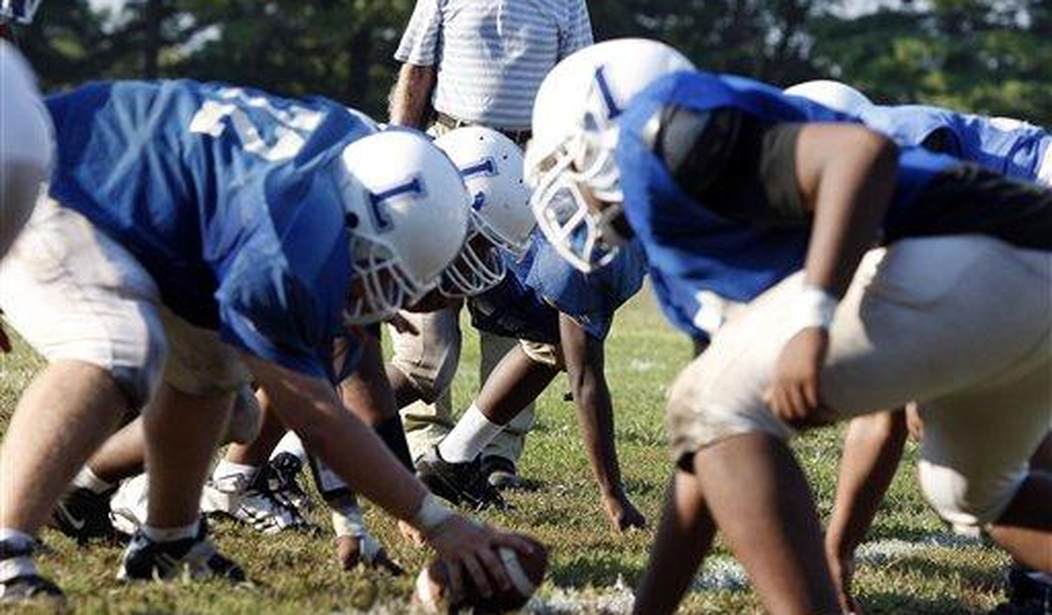There were 436,465 American high school boys who played soccer in the 2021-2022 school year and 481,004 who played baseball.
More than half a million -- 521,616 to be precise -- played basketball, while 569,262 competed in track and field.
These participation numbers made soccer, baseball, basketball and track among the most popular sports in which American high school boys chose to compete in that school year.
But 11-man tackle football beat them all.
In the 2021-22 school year, according to the National Federation of State High School Associations, 973,792 American high school boys played that game -- making it by far the most popular high school sport when measured by the number of students who participated in it.
(The most popular sport among high school girls was track and field, which attracted 456,697 female participants in the 2021-22 school year.)
Football was not just popular nationwide. It was popular in both red and blue states.
In California, for example, 44,179 high school boys played baseball; 47,091 played basketball; 48,452 competed in track and field; and 53,677 played soccer.
Yet, the Golden State had 84,626 high school boys playing 11-man tackle football.
Massachusetts saw a similar pattern. In the Bay State, 17,088 high school boys played football in the 2021-22 school year. That defeated the 8,114 who played lacrosse; the 12,651 who played basketball; the 13,331 who competed in track and field; and the 13,366 who played soccer.
In Ohio, not surprisingly, football was king. In that state, 15,961 high school boys played soccer; 21,213 played basketball; and 21,564 played baseball. But these numbers were dwarfed by the 40,267 who played football.
Football reigned in Florida, too. There, 18,249 high school boys competed in track and field; 18,269 played baseball; 19,378 played soccer; and 19,832 played basketball. But Florida's high school football teams brought 37,898 players onto their fields in the fall of 2021.
Recommended
Then there is Texas. The Lone Star State was the national champion when it came to fielding high school football players in the 2021 season. That year, 169,132 Texas high school boys played on 11-man tackle football teams in 2021.
As this column has noted before, there were 21 straight years (before the COVID pandemic), when at least 1 million American high school boys played football. These included every year from 1999 to 2019. During that stretch, the number of boys playing high school football hit a peak of 1,112,303 in 2008 -- but never dropped below the 1,002,734 level it achieved in 1999.
Because of the COVID pandemic, the National Federation of State High School Associations was not able to complete its annual survey of high school sports participation in the 2019-2020 and 2020-2021 school years.
But when the organization restarted its survey for the 2021-2022 school year, it discovered that although there was a minor decline in the number of high school boys playing 11-man football, there was an increase in the number of schools competing with football teams that put six to nine players on the field instead of 11.
"Perhaps the biggest storyline in boys participation totals, however, is the sport of football," the NFHS said when it released its survey last October. "While boys 11-player football was down three percent (1,006,013 to 973,792) -- less than the overall survey average of four percent -- participation in 6-, 8- and 9-player football registered a 12 percent increase -- from 31,221 to 34,935."
Walter Camp, the legendary Yale player and coach who was one of football's founding fathers, published "The Book of Foot-Ball" in 1910. He dedicated it to the players -- and their families.
"To every back who has bucked the line and to every line man who knows what it means to drive his charge home," he said, "to every one of the thousands of American foot-ball players who knows the satisfaction of plunging along over those white lines that mark the playing field, and finally to the thousands more of parents and brothers and sisters who have sat fascinated at the spectacle of the contest and with heart in throat pushed and held in spirit harder than any player on the huge gridiron this book is dedicated."
In the book, Camp countered the critics of football and explained how the merits of the sport were not merely physical.
"History shows that the game of foot-ball has been severely criticized and denounced and even forbidden by law," Camp wrote, "but with singular insistence it continues to assert its vitality, and it never was more popular than in America to-day. East and West, North and South, it spreads."
Camp argued that success in football was dependent less on raw physical ability than on courage, intelligence and hard work.
"'What makes a good foot-ball player?' is a question asked over and over again," Camp wrote. "Many are the answers given, but no answer is correct that does not contain the word 'pluck.' The same elements that go to make up excellence in any of the other field sports are requisite in foot-ball; but while in certain of the others that peculiar type of courage called pluck is required only in a moderate degree, in football it is absolutely indispensable. Many a man has said: 'Oh! I am too small to play foot-ball; I couldn't get on the team.' Such a man makes a mistake. Look at the records of our players, and see how full they are of the names of small men."
"This brings us to another quality: the brains of a team," said Camp. "That team is the best which has the most brains."
And then there is dedication to the cause.
"Endurance is another element of success," he concluded. "Plenty of dash when it is necessary, but behind it there must be the steady, even, staying qualities. For these, good training is chiefly responsible; because although natural endurance does exist in some men, it is not common, while the endurance of well-trained men is a thing that can be relied upon with confidence."
More than a century later, Camp's wisdom endures.























Join the conversation as a VIP Member